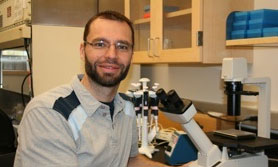
UM-Dearborn researcher Michael Twiner, assistant professor of biology, and a team of environmental researchers have made an innovative discovery regarding blue-green algae. The team found that the algae might produce an estrogen-like compound in the environment, which disrupts reproductive hormones and could be harmful to fish, other aquatic life and human health.
Using funding from the National Oceanic and Atmospheric Administration (NOAA) Ecology of Harmful Algal Blooms (ECOHAB), researchers compared groups of larval zebrafish exposed to Microcystis cells with those exposed to just the well-studied toxin they produce and found that only the fish in contact with the blue-green algal cells tested positive for a well-studied estrogenic biomarker. This led them to conclude the algal blooms were producing a previously unrecognized substance, which is an estrogen-like compound that acts as an endocrine disruptor.
"We know that industrial activities have released estrogenic-type compounds into the environmental in the past, but now there appears to be a new biological source that has never been observed before. It seems for the first time we have seen an indication that algae may be producing environmental estrogens, or as we have termed them, 'phycoestrogens' meaning algal-derived estrogens," said Twiner.
The research colleagues noted that harmful blooms of toxin-producing algae occur in waters throughout the world and are a growing health and environmental concern with possible human health effects include skin rashes, fever and liver damage.
"Dense accumulations or blooms of Microcystis are nearly annual events in many of Michigan's lakes and water reservoirs, including Lake Erie. Our laboratory findings that suggest the presence of an estrogenic compound during these bloom events certainly warrant subsequent studies and possibly more vigilant monitoring procedures," said Twiner.
The research is published in the American Chemical Society's journal, Environmental Science & Technology in an article titled "Global Gene Expression Profiling in Larval Zebrafish Exposed to Microcystin-LR and Microcystis Reveals Endocrine Disrupting Effects of Cyanobacteria," available at http://pubs.acs.org/doi/pdf/10.1021/es103538b.
The research group was led by Theodore Henry, an adjunct professor for UT Knoxville's Center for Environmental Biotechnology and faculty at the University of Plymouth and in addition to Twiner included Steven Wilhelm, professor of microbiology at UT Knoxville; Emily Rogers, graduate student at UT Knoxville's Center for Environmental Biotechnology and of the Department of Forestry, Wildlife and Fisheries; Julia Gouffon of UT Knoxville's Affymetrix Core Facility; Jackson McPherson of UT Knoxville's Center for Environmental Biotechnology; Gary Sayler, distinguished professor of microbiology at UT Knoxville; and Gregory Boyer of State University of New York College of Environmental Science and Forestry.
"This was truly an outstanding group of multi-disciplinary scientists with broad expertise that were brought together to approach a dynamic issue. Everyone had a significant role in this project and to be able to identify something so novel is a testament to the team," said Twiner.
NOAA is a federal agency focused on the condition of the oceans and the atmosphere. NOAA's mission is to understand and predict changes in the Earth's environment, from the depths of the ocean to the surface of the sun, and to conserve and manage coastal and marine resources.
Other press releases for these findings can be found at the American Chemical Society website: http://pubs.acs.org/cen/news/89/i07/8907scene1.html






